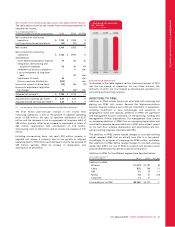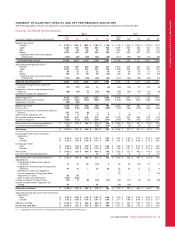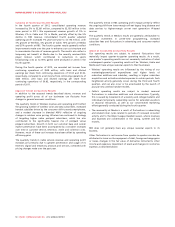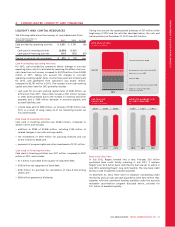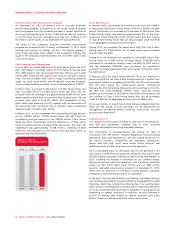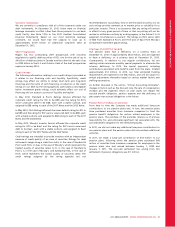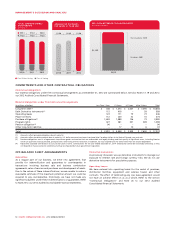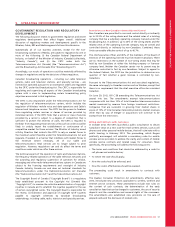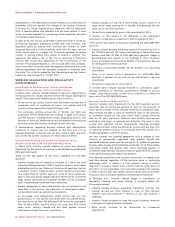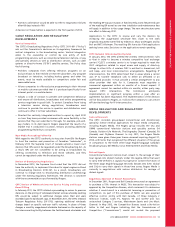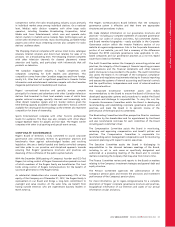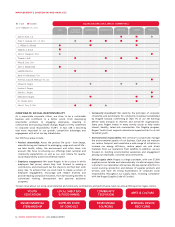Rogers 2012 Annual Report Download - page 56
Download and view the complete annual report
Please find page 56 of the 2012 Rogers annual report below. You can navigate through the pages in the report by either clicking on the pages listed below, or by using the keyword search tool below to find specific information within the annual report.
MANAGEMENT’S DISCUSSION AND ANALYSIS
Accounts Receivable Securitization Program
On December 31, 2012 we entered into an accounts receivable
securitization program. It enables us to sell certain trade receivables
into the program with the proceeds recorded in current liabilities as
revolving floating rate loans of up to $900 million. We will continue
to service these accounts receivables and they will continue to be
recorded in current assets on our Statement of Financial Position.
The terms of the Company’s accounts receivable securitization
program are committed until its expiry on December 31, 2015. Initial
funding was received on January 14, 2013. The buyer’s interest in
these trade receivables ranks ahead of the Company’s interest. The
buyer of the Company’s trade receivables has no further claim on any
of our other assets.
Debt Issuances and Redemptions
In June 2012, we issued $500 million of 3.0% Senior Notes due 2017
(the “2017 Notes”) and $600 million of 4.0% Senior Notes due 2022
(the “2022 Notes”). The net proceeds from the offering were $1,091
million after deducting the original issue discount and debt issuance
costs. The net proceeds were used to repay outstanding advances
under our bank credit facility and for general corporate purposes,
which included funding a portion of our ownership interest in MLSE.
In March 2011, we issued $1,450 million of 5.34% Senior Notes due
2021 and $400 million of 6.56% Senior Notes due 2041. The net
proceeds from the offerings were approximately $1,840 million after
deducting the original issue discount and debt issuance costs. The net
proceeds were used to fund the March 2011 redemption of two
public debt issues maturing in 2012, together with the termination of
the associated Debt Derivatives and to partially repay outstanding
advances under our bank credit facility.
In March 2011, we also redeemed the outstanding principal amount
of our US$350 million 7.875% Senior Notes due 2012 and the
outstanding principal amount of our US$470 million 7.25% Senior
Notes due 2012. Concurrently with the redemptions of these senior
notes, we terminated the associated Debt Derivatives. The total cash
expenditure was approximately $1,208 million, consisting of $878
million for the redemption of the senior notes and $330 million to
terminate the Debt Derivatives.
RATIO OF DEBT TO
ADJUSTED OPERATING PROFIT
2.1x 2.2x 2.3x
2010 2011 2012
Share Repurchases
In February 2012, we renewed our normal course issuer bid (“NCIB”)
to repurchase Class B Non-Voting shares of RCI for a further one-year
period. This allows us to purchase up to the lesser of 36.8 million Class
B Non-Voting shares, representing approximately 9% of the then-
issued and outstanding Class B Non-Voting shares, and that number
of Class B Non-Voting shares that can be purchased under the NCIB
for an aggregate purchase price of $1.0 billion.
During 2012, we purchased for cancellation 9,637,230 Class B Non-
Voting shares for $350 million. All of these shares were purchased
directly under the NCIB.
During 2011, we purchased for cancellation 30,942,824 Class B Non-
Voting shares for $1,099 million. Of these shares, 21,942,824 were
purchased for cancellation directly under the NCIB for $814 million,
and the remaining 9,000,000 were purchased for cancellation
pursuant to private agreements with arm’s-length third party sellers
for $285 million.
In February 2013, RCI filed a notice with the TSX of our intention to
renew our NCIB for our Class B Non-Voting shares for a further one-
year period. Subject to acceptance by the TSX, the TSX notice provides
that RCI may, during the twelve-month period, commencing
February 25, 2013 and ending February 24, 2014, purchase on the TSX,
the New York Stock Exchange (“NYSE”) and/or alternate trading
systems up to the lesser of 35.8 million Class B Non-Voting shares and
that number of Class B Non-Voting shares that can be purchased
under the NCIB for an aggregate purchase price of $500 million.
The actual number of Class B Non-Voting shares purchased under the
NCIB and the timing of such purchases will be determined by
management considering market conditions, stock prices, our cash
position and other factors.
Capital Resources
Our capital resources consist primarily of cash flow from operations,
cash and cash equivalents, available lines of credit, accounts
receivable securitization and long-term debt issuances.
This information is forward-looking and should be read in
conjunction with the section “Caution Regarding Forward-Looking
Statements, Risks and Assumptions” and the related disclosures for
the various economic, competitive and regulatory assumptions,
factors and risks that could cause actual future financial and
operating results to differ from those currently expected.
On a consolidated basis, we anticipate that we will generate a net
cash surplus in 2013 from our operations. We expect that we will have
sufficient capital resources to satisfy our cash funding requirements in
2013, including the funding of dividends on our common shares,
taking into account cash from operations and the amount available
under our $2.0 billion bank credit facility and our $900 million
accounts receivable securitization program. At December 31, 2012,
there were no restrictions on the flow of funds between subsidiary
companies or between RCI and any of its subsidiaries.
In the event that we require additional funding, we believe that any
such funding requirements may be satisfied by issuing additional debt
financing, which may include the restructuring of our existing bank
credit facility or issuing public or private debt or amending the terms
of our accounts receivable securitization program or issuing equity, all
depending on market conditions. In addition, we may refinance a
portion of existing debt subject to market conditions and other
factors. There is no assurance that this will or can be done.
52 ROGERS COMMUNICATIONS INC. 2012 ANNUAL REPORT







